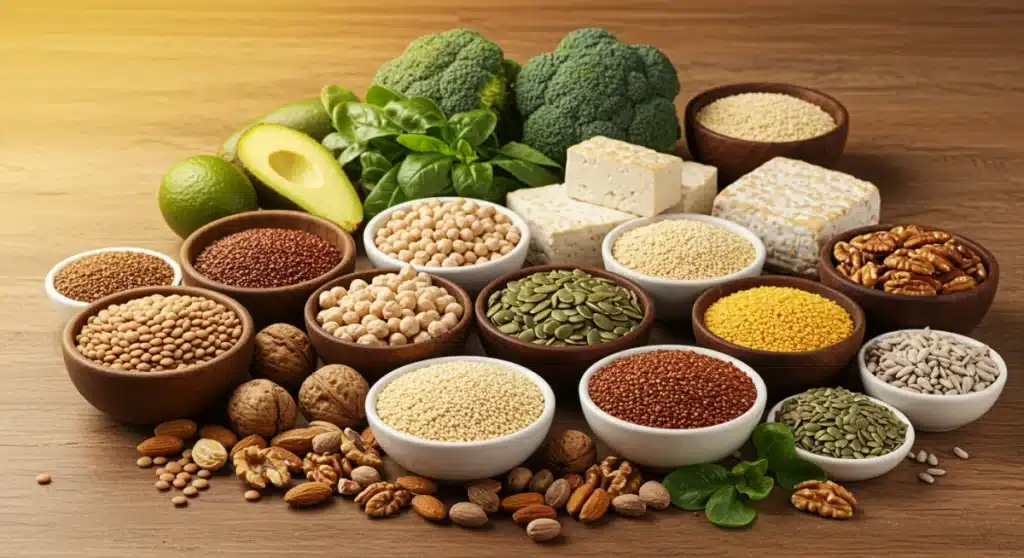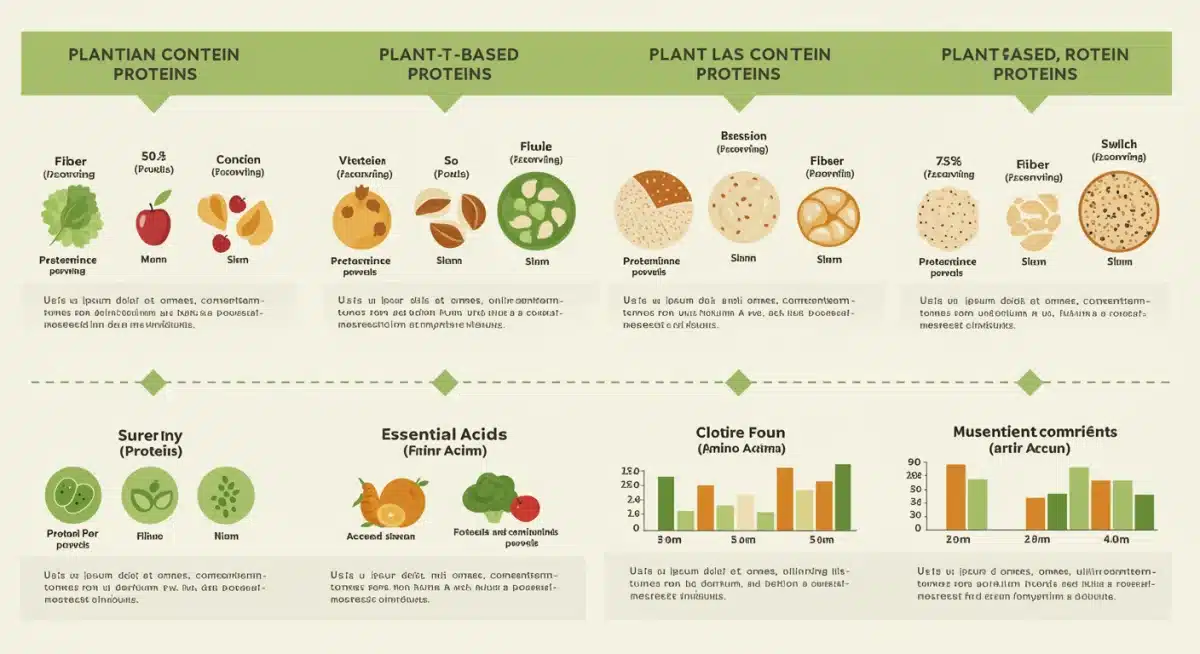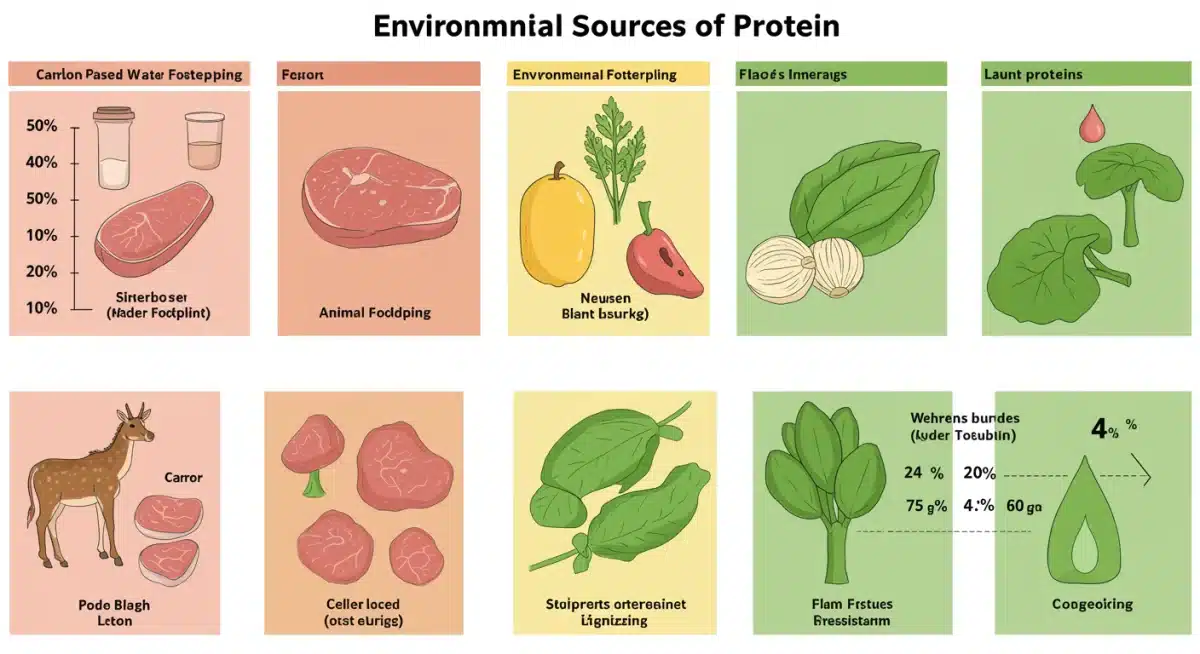Plant-Based Proteins: 2025 Cost, Nutrition & Sustainability

Plant-based proteins are increasingly vital for healthy eating, offering diverse nutritional benefits and substantial environmental advantages over animal products, with evolving cost-effectiveness in 2025.
As we navigate 2025, the landscape of dietary choices continues to evolve, with an increasing focus on sustainable and health-conscious eating. Among these trends, plant-based protein comparison has emerged as a critical discussion point, influencing everything from grocery budgets to global environmental efforts.
The Rise of Plant-Based Proteins: A 2025 Overview
The shift towards plant-based diets is no longer a niche movement; it’s a mainstream culinary and lifestyle revolution. In 2025, consumers are more informed than ever about the implications of their food choices, driving demand for alternatives that align with health, ethical, and environmental values. This section explores the current state of plant-based proteins, setting the stage for a detailed comparison.
The market for plant-based foods has seen exponential growth, fueled by innovations in food science and a greater understanding of nutritional needs. From traditional legumes and grains to sophisticated meat analogues, the variety available is vast, making it easier for individuals to transition or incorporate more plant-based options into their diets. This expansion also means a wider range of price points and nutritional profiles, which is crucial for consumers making informed decisions.
Market Dynamics and Consumer Trends
Several factors are contributing to the sustained growth of the plant-based protein market. Increased awareness of the environmental impact of animal agriculture, coupled with health benefits associated with plant-rich diets, are primary drivers. Furthermore, advancements in food technology have made plant-based products more appealing in terms of taste, texture, and convenience.
- Growing consumer awareness of health benefits.
- Environmental concerns regarding traditional meat production.
- Technological innovations improving product quality.
- Increased availability in mainstream grocery stores and restaurants.
This evolving market presents both opportunities and challenges. While diversity is a boon, navigating the myriad options can be complex. Understanding the underlying nutritional value, cost implications, and true sustainability credentials of each type of plant-based protein is essential for making choices that truly benefit both individual health and the planet.
In conclusion, 2025 marks a pivotal year for plant-based proteins, characterized by unprecedented growth and consumer interest. The expansion of the market necessitates a deeper dive into the specific attributes of these proteins to help consumers make truly informed decisions that align with their personal values and health goals.
Cost-Effectiveness Analysis: Plant-Based vs. Animal Proteins in 2025
When considering dietary changes, cost is often a significant factor. In 2025, the economic landscape of food is dynamic, with inflation and supply chain issues impacting prices across the board. This section provides a detailed cost-effectiveness analysis of various plant-based proteins compared to their animal-based counterparts, helping consumers understand where their dollar goes furthest.
Traditionally, plant-based staples like beans, lentils, and rice have been significantly cheaper than meat. However, the emergence of highly processed plant-based meat alternatives has introduced a new price point, often comparable to, or even exceeding, that of conventional meat products. Understanding this spectrum is key to managing a budget-friendly plant-based diet.
Affordable Plant-Based Staples
Whole, unprocessed plant-based proteins remain the most economical choices. These include:
- Dried beans and lentils: Extremely cost-effective per serving.
- Tofu and tempeh: Generally affordable, especially in larger blocks.
- Grains like quinoa and brown rice: Higher upfront cost but yield many servings.
- Peanuts and sunflower seeds: Inexpensive sources of protein and healthy fats.
These options provide excellent nutritional value without breaking the bank, making them accessible for a wide range of budgets. Their versatility in cooking also allows for creative and diverse meal planning, further maximizing their value.
Conversely, newer plant-based meat alternatives, such as burgers, sausages, and chicken substitutes, often come at a premium. While their taste and texture mimic animal products, the manufacturing processes and marketing efforts contribute to higher retail prices. Consumers must weigh the convenience and sensory experience against the cost, especially if they are trying to maintain a strict budget.
Considering the long-term, a diet rich in whole plant foods can lead to significant savings on groceries, particularly when compared to a diet heavily reliant on meat and dairy. Furthermore, potential health benefits from such a diet could also lead to reduced healthcare costs over time, though this is harder to quantify directly.
In summary, while some processed plant-based options can be pricey, a plant-based diet built around whole foods is generally more cost-effective than an animal-product-heavy diet in 2025. Strategic shopping and meal planning can further enhance these savings.
Nutritional Powerhouses: A Deep Dive into Plant-Based Protein Profiles
Beyond cost, the nutritional value of proteins is paramount. This section delves into the detailed nutritional profiles of various plant-based proteins, comparing their protein content, essential amino acid completeness, fiber, vitamins, and minerals. Understanding these aspects is crucial for ensuring a balanced and healthy diet, especially for those transitioning to or maintaining a plant-focused lifestyle.
One common misconception about plant-based proteins is that they are inherently ‘incomplete’ in terms of essential amino acids. While some individual plant sources may lack one or two essential amino acids, a varied plant-based diet easily provides all necessary amino acids. The concept of ‘protein complementarity’ – combining different plant proteins throughout the day – effectively addresses this.

Complete Plant Proteins and Complementarity
Certain plant proteins are considered ‘complete,’ meaning they contain all nine essential amino acids in sufficient quantities. These include:
- Quinoa: A grain that is a complete protein.
- Soy products (tofu, tempeh, edamame): Excellent sources of complete protein.
- Buckwheat: Another complete protein grain.
- Pistachios: A nut with a surprisingly complete amino acid profile.
For other plant proteins, combining them throughout the day ensures complete amino acid intake. For instance, pairing legumes (rich in lysine) with grains (rich in methionine) creates a complete protein meal. This approach is naturally achieved in a diverse plant-based diet.
Beyond protein, plant-based sources offer a wealth of other beneficial nutrients. They are typically high in fiber, which is crucial for digestive health and satiety, and often contain a range of vitamins (like B vitamins in legumes) and minerals (such as iron in spinach and lentils, and zinc in pumpkin seeds). They also tend to be lower in saturated fat and cholesterol compared to many animal proteins, contributing to better cardiovascular health.
It’s also important to note that many plant-based proteins come with a bonus of antioxidants and phytochemicals, substances known for their disease-fighting properties. These compounds are largely absent in animal products, giving plant-based diets an additional health edge.
Ultimately, a well-planned plant-based diet provides all the necessary nutrients, including protein, often with added health benefits. The key lies in variety and understanding the unique nutritional contributions of different plant foods.
Sustainability Footprint: Environmental Impact of Protein Choices
In 2025, environmental sustainability is a non-negotiable consideration for food production. The ecological footprint of various protein sources differs dramatically, with significant implications for climate change, land use, and water resources. This section examines the sustainability credentials of plant-based proteins compared to animal proteins, highlighting why plant-forward diets are increasingly seen as a vital solution for a healthier planet.
The livestock industry is a major contributor to greenhouse gas emissions, deforestation, and water pollution. Producing meat, particularly beef, requires vast amounts of land for grazing and feed cultivation, as well as substantial water resources. The waste generated also poses environmental challenges, impacting ecosystems and biodiversity.
Reducing Carbon Footprint with Plant Proteins
Plant-based proteins generally have a much lower environmental impact. Consider these factors:
- Lower greenhouse gas emissions: Plants require less energy and produce fewer emissions than livestock.
- Reduced land use: Growing crops for direct human consumption is far more efficient than growing feed for animals.
- Less water consumption: Most plant proteins have a significantly smaller water footprint than animal proteins.
- Biodiversity preservation: Less intensive agriculture can help protect natural habitats.
The efficiency of converting plant matter into human-edible protein is significantly higher than feeding plants to animals and then consuming the animal. This direct consumption model reduces resource waste at multiple levels, making it a more sustainable pathway for global food security.
While some plant-based products, especially those that are highly processed or rely on monoculture crops, can have their own environmental concerns, the overall impact of plant-based diets remains substantially lower than that of meat-heavy diets. Innovations in sustainable agriculture and responsible sourcing are continuously working to mitigate these issues within the plant-based sector.

Choosing plant-based proteins is a powerful way for individuals to contribute to environmental preservation. Every meal can be a step towards reducing one’s carbon footprint and supporting a more sustainable food system. As climate challenges intensify, the role of plant-based diets in fostering ecological balance becomes even more critical.
In essence, from a sustainability perspective, plant-based proteins offer a clear advantage. Their production requires fewer resources and generates less pollution, aligning perfectly with the urgent need for more eco-friendly food systems in 2025.
Emerging Plant-Based Protein Trends and Innovations in 2025
The plant-based protein market is not static; it’s a hotbed of innovation. In 2025, we are witnessing exciting new trends and technological advancements that are reshaping how we perceive and consume plant-based proteins. This section explores these cutting-edge developments, from novel protein sources to advanced processing techniques, and their potential impact on cost, nutrition, and sustainability.
Food scientists and entrepreneurs are constantly pushing boundaries, creating products that are more delicious, nutritious, and environmentally friendly. These innovations are crucial for attracting a broader consumer base and making plant-based diets even more accessible and appealing to the general public.
Novel Protein Sources and Technologies
Several new sources and technologies are gaining traction:
- Mycoprotein: Derived from fungi, mycoprotein offers a meat-like texture and high protein content with minimal environmental impact.
- Algae-based proteins: Spirulina and chlorella are being explored for their excellent nutritional profiles and sustainable cultivation methods.
- Precision fermentation: This technology allows for the production of specific proteins (like whey or casein) using microorganisms, without animal involvement.
- Cellular agriculture (plant-based scaffolding): While not strictly plant-based protein, it often uses plant materials as a base for cultivating animal cells, reducing the need for traditional livestock.
These innovations promise to address some of the current limitations of plant-based proteins, such as texture, flavor, and specific nutrient delivery. For instance, precision fermentation could enable the creation of dairy-free cheeses and yogurts with identical protein structures to their animal counterparts, offering enhanced functionality and taste.
Furthermore, research into optimizing existing plant protein sources continues. For example, improved extraction methods for proteins from pulses or grains can lead to more concentrated and functional ingredients for food manufacturers. This not only enhances product quality but can also improve the cost-effectiveness of these ingredients.
The focus on sustainability is also driving innovation. Companies are exploring vertical farming and other controlled environment agriculture techniques for protein-rich crops, reducing land and water use, and minimizing transportation costs and emissions. These advancements are critical for ensuring that the future of plant-based proteins is both innovative and environmentally responsible.
In conclusion, the plant-based protein sector in 2025 is characterized by dynamic innovation. These emerging trends and technologies are set to further enhance the appeal, nutritional value, and sustainability of plant-based options, making them an even more compelling choice for consumers worldwide.
Making Informed Choices: Integrating Plant-Based Proteins into Your Diet
With a comprehensive understanding of cost, nutrition, and sustainability, the next step is to effectively integrate plant-based proteins into your daily diet. This section provides practical advice and strategies for consumers in 2025 to make informed choices, ensuring they meet their dietary needs while aligning with their personal values. It emphasizes variety, meal planning, and understanding product labels.
Transitioning to a more plant-based diet doesn’t have to be an all-or-nothing endeavor. Even small changes, such as incorporating one plant-based meal a day or swapping out a portion of meat for legumes, can have significant positive impacts on health and the environment. The key is to start where you are and gradually build up.
Practical Tips for Plant-Based Eating
To successfully integrate plant-based proteins, consider these practical tips:
- Embrace variety: Consume a wide range of legumes, grains, nuts, and seeds to ensure a complete nutrient profile.
- Read labels carefully: Pay attention to protein content, added sugars, sodium, and saturated fats in processed plant-based products.
- Meal prep: Cook larger batches of staples like beans or quinoa to save time and ensure healthy options are always available.
- Experiment with recipes: Discover new plant-based dishes that excite your palate and prevent dietary boredom.
Understanding product labels is particularly important for newer plant-based alternatives. While many are healthier than their animal counterparts, some can be highly processed and contain high levels of sodium or unhealthy fats. Opting for whole-food-based options whenever possible is generally the best approach for maximizing nutritional benefits.
For those concerned about specific nutrients like Vitamin B12, iron, or Omega-3 fatty acids, strategic planning is essential. B12 supplementation is often recommended for strict vegans, while iron absorption can be enhanced by pairing iron-rich plant foods with Vitamin C sources. Omega-3s can be obtained from flaxseeds, chia seeds, and walnuts.
The accessibility of plant-based foods in 2025, from grocery stores to restaurants, makes it easier than ever to adopt this lifestyle. Many online resources, cookbooks, and communities offer support and inspiration for plant-based cooking and eating. Leveraging these resources can make the transition smoother and more enjoyable.
Ultimately, making informed choices about plant-based proteins involves a blend of nutritional understanding, cost awareness, and a commitment to sustainability. By following these guidelines, individuals can confidently navigate the diverse world of plant-based eating and reap its many rewards.
The Future Outlook: Plant-Based Proteins Beyond 2025
Looking beyond 2025, the trajectory for plant-based proteins appears to be one of continued growth, innovation, and increasing integration into global food systems. This final section speculates on the future of plant-based proteins, considering how evolving consumer demands, technological advancements, and environmental pressures will shape their role in our diets and on our planet.
The momentum gained by plant-based eating is unlikely to wane. As populations grow and environmental challenges become more pressing, the imperative to find sustainable and efficient ways to feed the world will only intensify. Plant-based proteins offer a robust solution to many of these complex issues.
Projected Growth and Societal Impact
Key areas of future development include:
- Further technological breakthroughs: Expect even more sophisticated meat and dairy alternatives that are indistinguishable from their animal counterparts.
- Personalized nutrition: Plant-based options tailored to individual genetic and lifestyle needs, perhaps via AI-driven dietary recommendations.
- Global policy shifts: Governments may increasingly incentivize plant-based agriculture and consumption to meet climate goals.
- Integration into diverse cuisines: Plant-based ingredients and products will become even more common across all culinary traditions worldwide.
The cost of plant-based alternatives is also expected to become more competitive. As production scales up and technologies become more efficient, the premium associated with some processed plant-based products will likely decrease, making them accessible to an even broader demographic. This democratization of plant-based options will be crucial for widespread adoption.
From a nutritional standpoint, ongoing research will continue to refine our understanding of optimal plant-based diets, potentially leading to new fortified products or specific recommendations for different life stages. The focus will remain on ensuring that plant-based diets are not just adequate, but optimal for human health.
Environmentally, the continued shift towards plant-based proteins will play a significant role in mitigating climate change, preserving biodiversity, and conserving natural resources. This collective impact, driven by individual choices and systemic changes, holds the promise of a more sustainable and resilient food future.
In essence, the future of plant-based proteins beyond 2025 is bright and transformative. They are poised to become an even more central component of a healthy, sustainable, and equitable global food system, offering solutions to some of humanity’s most pressing challenges.
| Key Aspect | Description in 2025 |
|---|---|
| Cost-Effectiveness | Whole plant foods generally cheaper; processed alternatives vary, sometimes premium. |
| Nutritional Profile | Diverse sources provide complete amino acids, high fiber, vitamins, and minerals. |
| Sustainability | Significantly lower carbon footprint, land, and water use compared to animal proteins. |
| Innovation & Trends | Emergence of mycoprotein, algae, precision fermentation, and improved processing. |
Frequently Asked Questions About Plant-Based Proteins in 2025
Not always. While whole plant foods like beans and lentils remain highly economical, highly processed plant-based meat alternatives can sometimes be comparable to, or even more expensive than, conventional meat products due to manufacturing and marketing costs.
Yes, absolutely. A varied plant-based diet that includes a range of legumes, grains, nuts, and seeds throughout the day will provide all essential amino acids. Some plant foods like quinoa and soy are even complete proteins on their own.
Choosing plant-based proteins significantly reduces your carbon footprint, land use, and water consumption compared to animal agriculture. They also contribute less to deforestation and water pollution, supporting overall biodiversity and ecological health.
Beyond 2025, we anticipate further advancements in mycoprotein, algae-based proteins, and precision fermentation technologies. These innovations aim to create more diverse, nutritionally superior, and environmentally friendly plant-based options, enhancing taste and texture.
To ensure optimal nutrition, focus on variety by incorporating diverse plant protein sources. Pay attention to consuming adequate iron, B12 (often supplemented), and Omega-3s. Read food labels, and consider meal planning to maintain a balanced intake of nutrients.
Conclusion
In 2025, the conversation around plant-based proteins has matured significantly, moving beyond simple dietary trends to a critical assessment of their role in global health and environmental sustainability. Our detailed plant-based protein comparison reveals that these food sources offer compelling advantages in terms of nutritional density, often at a more accessible cost when focusing on whole foods, and with a substantially lower ecological footprint. As innovation continues to drive the sector forward, the options for incorporating plant-based proteins into a healthy, sustainable diet are only expanding. Making informed choices now not only benefits individual well-being but also contributes to a more resilient and responsible future for our planet, reinforcing the crucial link between our plates and planetary health.





